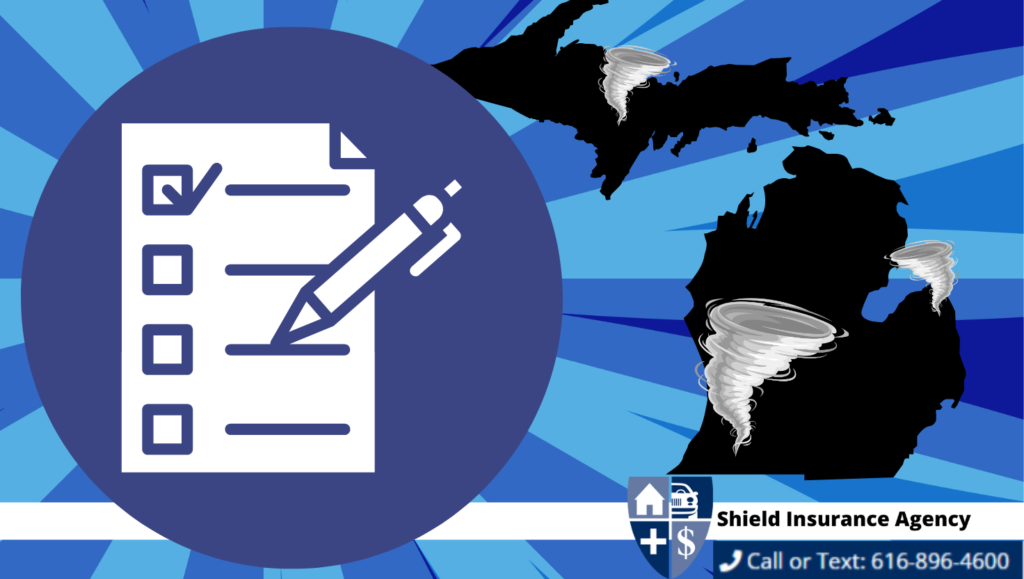Michigan Tornado
On average Michigan has 15 tornadoes per year. Tornadoes are known to develop rapidly, with little advanced warning. The average lead time for a Michigan tornado warning is 10 to 15 minutes and winds can reach over 200 mph, which is why Michigan residents are encouraged to prepare and make a plan before a tornado strikes.
Each year during Severe Weather Awareness Week, a statewide tornado drill is held so you can practice your plan.
BE PREPARED:
Terms:
Michigan Tornado Watch: Tornadoes are possible. When there is a Watch, move near enough to a shelter or sturdy building to be able to get inside quickly if there is a Warning or if you see signs of a tornado approaching. Remain alert for approaching storms. Watch the sky and stay tuned to NOAA Weather Radio, commercial radio, or television for information.
Michigan Tornado Warning: A tornado has been sighted or indicated by weather radar. Take shelter immediately.
Supercell: A system producing severe thunderstorms, featuring rotating winds sustained by a prolonged updraft that may result in hail or tornadoes.
Enhanced Fujita (EF) Scale: Rates the strength of tornadoes in the United States and Canada. There are six categories for the EF scale and are in order of increasing intensity. *It is based on wind estimates of a 3-second gust.*
- EF0: Tornadoes with an estimated wind speed of 65-85 mph and leads to light damage.
- EF1: Estimated wind speed of 86-110 mph with the potential of moderate damage.
- EF2: Estimated wind speeds of 111-135 mph with significant damage potential.
- EF3: Estimated wind speeds of 136-165 mph with severe damage potential.
- EF4: Estimated wind speeds of 166-200 mph with devastating damage potential.
- EF5: Estimated wind speeds of over 200 mph with incredible damage potential.
Before a Michigan Tornado:
- Identify safe rooms built to FEMA criteria or ICC500 storm shelters or other potential protective locations in sturdy buildings near your home, work, and other locations you frequent so you have a plan for where you will go quickly for safety when there is a Warning or an approaching tornado.
- For schools, malls, and other buildings with long-span roofs or open space plans, or many occupants, ask the building manager to identify the best available refuge.
- Build an emergency kit and make a family communications plan.
- Sign up for your community’s warning system. The Emergency Alert System (EAS) and National Oceanic and Atmospheric Administration (NOAA) Weather Radio also provide emergency alerts. If your community has sirens, become familiar with the warning tone.
- Listen to NOAA Weather Radio or to commercial radio or television newscasts for the latest information. Meteorologists can predict when conditions might be right for a tornado. In an emergency, always listen to the instructions given by local emergency management officials.
- Be alert to changing weather conditions. Look for approaching storms.
- Look for the following danger signs:
- Dark, often greenish sky
- Large hail
- A large, dark, low-lying cloud (particularly if rotating)
- Loud roar, similar to a freight train.
- If you see approaching storms or any of the danger signs, be prepared to take shelter immediately.
During a Tornado:
- If you are under a tornado warning, seek shelter immediately! Most injuries associated with high winds are from flying debris, so remember to protect your head.
- If you are in school, nursing home, hospital, factory, shopping center, high-rise building then:
- Go to a pre-designated area such as a safe room built to FEMA criteria, basement, storm shelter, or the lowest building level. If there is no basement, go to the center of a smaller interior room, such as a closet or hallway, that is away from corners, windows, doors, and outside walls. Put as many walls as possible between you and the outside. Get under a sturdy table and cover your head and neck with your arms and cover your body as best you can e.g., with a heavy coat or blankets, pillows.
- In a high-rise building, go to a small interior room or hallway on the lowest floor possible.
- Do not open windows.



















































